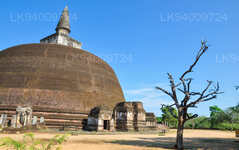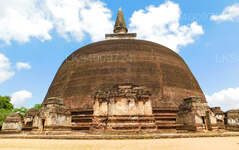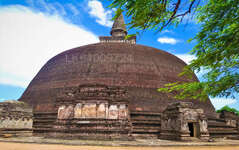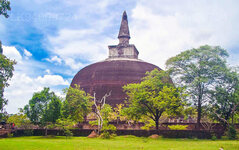
Polonnaruwa City
Polonnaruwa, a UNESCO World Heritage Site in Sri Lanka, was the country's medieval capital (11th-13th century). Renowned for its well-preserved ruins, including the iconic Gal Vihara statues, it showcases impressive architecture, reflecting the grandeur of the ancient Sinhalese civilization.
Rankoth Vehera
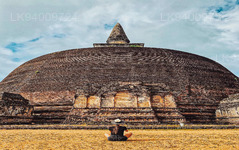

Rankoth Vehera in Sri Lanka: Stupa mit dem Goldenen Gipfel
Polonnaruwa war nach dem Königreich Anuradhapura das zweite Königreich der alten Könige Sri Lankas. In Anlehnung an die ältere Tradition der Könige des ersten Königreichs hielten es auch die Polonnaruwa- Könige für angebracht, ihre Fußabdrücke in Form von Stupas zu hinterlassen, die während ihrer Regierungszeit errichtet wurden. Die Stupas unterschieden sich im Design normalerweise von denen der Anuradhapura- Könige und folgten einem für Polonnaruwa einzigartigen Stil, es gab jedoch einige Ausnahmen.Rankoth Vehera in Sri Lanka: Ähnelt Ruwanwelisaya
Ruwanweli ist ein Stupa, der vom König Nissanka Malla erbaut wurde, der Polonnaruwa regierte (1187 – 1196 n. Chr.). Es wurde im Stil der ursprünglichen Stupas des Anuradhaphura Maha Vihara-Klosters erbaut und weist große Ähnlichkeit mit einem der berühmtesten Stupas Sri Lankas auf – „Ruwanwelisaya“. Der ursprüngliche Name des Stupa deutet darauf hin, dass diese Ähnlichkeit möglicherweise beabsichtigt war. Der Name wurde jedoch später in „Rankoth Vehera“ geändert. „Ran“ bedeutet Gold und „koth“ ist das Wort für die Spitze eines Stupas in der singhalesischen Sprache. Daher ähnelt Rankoth Vehera im Englischen „Stupa mit dem goldenen Gipfel“. Rankoth Vehera ist einer der bekanntesten und am meisten verehrten Stupas der Polonnaruwa- Ära.
Rankoth Vehera in Sri Lanka: 10 Dinge, die Sie über Rankoth Vehera wissen sollten
- Ziegel war das einzige Baumaterial, das im gesamten Stupa verwendet wurde.
- Der kreisförmige Sockel von Rankoth Vehera hat einen Durchmesser von etwa 170 m (550 Fuß) und eine Höhe von etwa 33 m (108 Fuß) an der Spitze des Stupa.
- Spätere Herrscher führten jedoch Renovierungsarbeiten im oberen Teil von Rankoth Vehera durch und veränderten die Höhe des Bauwerks. Untersuchungen haben gezeigt, dass die ursprüngliche Höhe des Stupa möglicherweise bis zu 61 m (200 Fuß) betrug.
- Auch nach dem drastischen Rückgang bleibt Rankoth Vehera der größte Stupa in Polonnaruwa und der viertgrößte des Landes.
- Rankoth Vehera verfügt über vier Vahalkadas, die das Gewicht der Stupa tragen und ebenfalls aus Ziegeln bestehen.
- Der gesamte Stupa liegt in der Mitte einer großen quadratischen Terrasse, die von einer Backsteinmauer umgeben ist.
- Die Terrasse verfügt über vier Eingänge in Richtung der vier Himmelsrichtungen, zu denen Sandwege führen.
- Auf einem Stein in der Nähe eines Eingangs steht die Inschrift, dass König Nissanka Malla über den Bau des Stupa wachte und ihn überwachte.
- Die Inschrift erwähnt auch, dass er den Stupa von einer Steinplattform aus verehrte.
- Diese Plattform befindet sich an einer Ecke der Terrasse, auf der der Stupa steht.
Polonnaruwa verfügt zusammen mit Anuradhapura über eine wahre Schatzkammer gut erhaltener historischer Orte, die es zu besuchen gilt, wie zum Beispiel Rankoth Vehera.
About Polonnaruwa District
Polonnaruwa is the 2nd largest city in north central province in Sri Lanka. The ancient city of Polonnaruwa has been declared a World Heritage site by UNESCO Polonnaruwa has a great history of conquest and struggle behind it and rightfully forms the third element in the Cultural Triangle. Located about 140 kms north east from Kandy,Polonnaruwa offers hours of endless pleasure for history and culture lovers, as there are numerous sights of significance.
Much of the physical ruins standing today are credited to King Parakrama Bahu I who spent many royal resources on town planning, including parks, edifices, irrigation systems and so on. The period of his rule is considered a golden age where the kingdom thrived and prospered under a visionary ruler. The Parakrama Samudra is a mammoth tank and named after its patron. The popular kings Royal Palace, the Audience Hall encircled by beautifully carved stone elephants and the Bathing Pool reflect the superior engineering capabilities of the time.
About North Central Province
North Central Province which is the largest province in the country covered 16% of total country's land area. North Central Province consist two districts called Polonnaruwa and Anuradhapure. Anuradhapura is the largest district in Sri Lanka. Its area is 7,128 km².
North Central Province has numerous potentials for Investors to start their Businesses, especially Agriculture, agro based industries and Livestock sectors. More than 65% of North Central Province's people depend on basic Agriculture and agro base industries. NCP also called "Wew Bendi Rajje" because there are more than 3,000 medium and large scale tanks situated in the province. Sri maha bodiya, Ruwanweli seya, Thuparama dageba, Abayagiri Monastry, Polonnaruwa Rankot wehera, Lankathilake are scared

